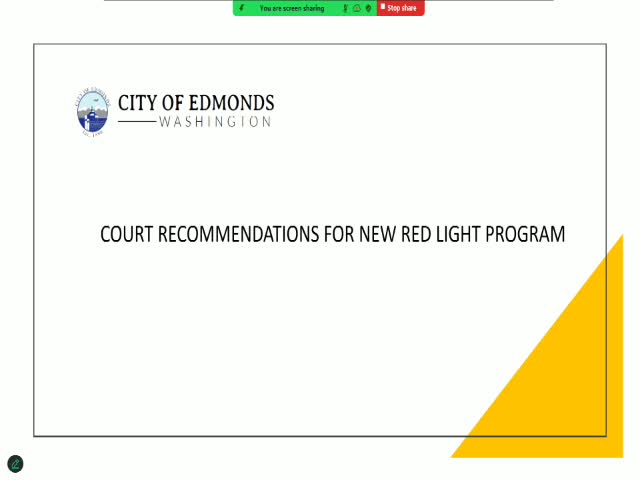Court budget plan sparks debate over red light program
October 22, 2024 | Edmonds, Snohomish County, Washington
This article was created by AI summarizing key points discussed. AI makes mistakes, so for full details and context, please refer to the video of the full meeting. Please report any errors so we can fix them. Report an error »

During a recent government meeting, officials discussed the financial implications and operational requirements of a new red light camera enforcement program set to begin in 2025. The program is projected to generate an estimated revenue of $2.5 million, with a focus on managing the anticipated workload for the court system.
The meeting highlighted the allocation of 1.5 full-time equivalent (FTE) positions for the court to handle the expected influx of cases stemming from the program. With three cameras authorized for installation—two on Highway 99 and one on State Route 104—the estimated monthly citations are projected to reach 2,450. This figure is based on reasonable assumptions regarding citation rates per camera, despite some uncertainties surrounding exact numbers.
Key operational impacts were outlined, particularly concerning the time required for clerks and judicial staff to process cases. Each citation will necessitate approximately 2.1 minutes for document preparation and an additional 5 minutes for money management. Cases requiring hearings could demand up to 20 minutes of further processing. The total estimated clerk hours needed per month is around 441, translating to a need for approximately 2.76 FTEs.
In light of these projections, officials recommended adjusting the budgeted revenue to reflect a more conservative estimate, alongside requests for additional funding for clerks, Pro Tem judicial positions, and interpreter services. The proposed budget includes $25,000 annually for Pro Tem positions and $15,000 for interpreter services, acknowledging the potential for increased technology costs as new staff are onboarded.
The implementation of the program will not be immediate, as a warning period is planned for the first month, delaying the full impact on court operations until March 2025. The meeting concluded with an invitation for council members to pose questions regarding the program and its implications for the community.
The meeting highlighted the allocation of 1.5 full-time equivalent (FTE) positions for the court to handle the expected influx of cases stemming from the program. With three cameras authorized for installation—two on Highway 99 and one on State Route 104—the estimated monthly citations are projected to reach 2,450. This figure is based on reasonable assumptions regarding citation rates per camera, despite some uncertainties surrounding exact numbers.
Key operational impacts were outlined, particularly concerning the time required for clerks and judicial staff to process cases. Each citation will necessitate approximately 2.1 minutes for document preparation and an additional 5 minutes for money management. Cases requiring hearings could demand up to 20 minutes of further processing. The total estimated clerk hours needed per month is around 441, translating to a need for approximately 2.76 FTEs.
In light of these projections, officials recommended adjusting the budgeted revenue to reflect a more conservative estimate, alongside requests for additional funding for clerks, Pro Tem judicial positions, and interpreter services. The proposed budget includes $25,000 annually for Pro Tem positions and $15,000 for interpreter services, acknowledging the potential for increased technology costs as new staff are onboarded.
The implementation of the program will not be immediate, as a warning period is planned for the first month, delaying the full impact on court operations until March 2025. The meeting concluded with an invitation for council members to pose questions regarding the program and its implications for the community.
View full meeting
This article is based on a recent meeting—watch the full video and explore the complete transcript for deeper insights into the discussion.
View full meeting
